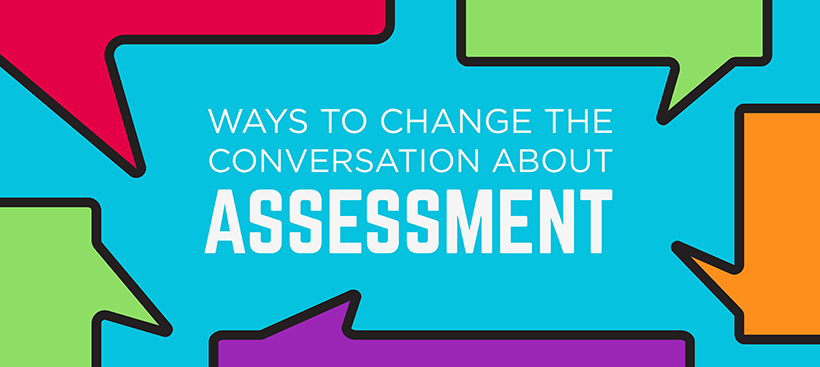From the NCTE Standing Committee on Literacy Assessment
This blog was written by NCTE member Kathleen Blake Yancey, a member of the NCTE Standing Committee on Assessment
During the summer months—now coming to a close, alas!—I try to step back and pay attention to what is going on in education generally. What new teaching strategies are helping students learn? What new assessment strategies can credit students’ literacy achievement and support their future literacy learning? Of course, the way I have just defined literacy assessment, it’s a credit—and learning-based activity—exactly the way the members of the Standing Committee on Literacy Assessment have understood it.
Two new practices came to my attention this summer, both of them assessment practices located in learning, with one of them worth watching, I think, and another worth adopting.
The first of these, the brainchild of the “Mastery Transcript Consortium” reimagines the high school transcript. Rather than simply listing courses and grades as the conventional transcript does, the “Mastery Transcript” displays students’ accomplishments in several areas without numerical representations.
In this model of the transcript, it’s not that achievement doesn’t count: it does, but it’s targeted to mastery, in this case mastery of a “specific skill, knowledge block, or habit of mind” (Mastery Transcript Consortium), each of which can be evidenced by “projects, employment, or internship experience” (Anderson).
As important, this digitally interactive transcript can include cross-disciplinary credits as well as school-defined credits. In conceptualizing accomplishments so capaciously, this transcript thus can provide opportunities for students to showcase attributes and experiences like leadership.
Of course, the proof is in the pudding, and while I looked for an example online, I was unable to find one, so I’m not sure what these transcripts actually look like. That might be expected, though, given that the effort is still in a pilot phase. Still, some in higher education are optimistic about this digital transcript’s potential.
Zina Evans, Vice-President for Enrollment Management at the University of Florida, for instance, noted that this transcript, unlike the traditional one, could help college admission officials understand not only what a student accomplished, but also how he or she “got there.”
She also said that such a transcript might “produce more diversity and equity in the admissions process . . . making it easier for colleges to admit more standout nontraditional students with an array of personal and educational experiences” (Anderson). This new practice is promising, I think, and I’ve signed up for their newsletter—as you can, too!—so I can see how this Mastery Transcript develops and what impact it has.

The second practice, the “Backpack of Success Skills initiative in Jefferson County Public Schools (JCPS) in Louisville,” invites students in elementary school, middle school, and high school to collect their work in a digital portfolio, which they call a backpack. It focuses on five areas:
- Emerging innovator
- Productive collaborator
- Effective communicator
- Globally and competent citizen
- Prepared and resilient learner
Then, at three transition years—fifth, eighth, and twelfth grade[s]—“students have an opportunity to defend their growth and readiness” for the next school context (middle school, high school, postsecondary) by presenting their work to a panel that often includes community members, much like the portfolio presentations teachers in our Assessment Story project identified
Moreover, in this learning and presenting process, students don’t fail. For one thing, students can use the presentation as a chance to think about “the projects and assignments that did not work, and how some even took multiple attempts to master, but why they felt more resilient and prepared because of learning from their failures” (Sullivan).
And for another, students who are not ready to pass receive more opportunities to learn before presenting again. In this sense, it reminds me of the way medical school works. During my daughter’s first year in med school, she had a colleague who was failing one of the classes. Alarmed, I asked her what would happen if he failed: “oh, he’ll just take it again until he passes.” That kind of opportunity—learning until achievement is accomplished—should be available to all learners, I think, and in the Backpack Project it is.
And a bonus: included on the site explaining the Backpack Project is a wonderful video with elementary school kids talking about what they have learned, explaining their test scores as well as their projects, and responding to panelists’ questions. It does a wonderful job of showing both learning-completed and learning-in-action.
These two promising practices point us toward better ways to support learning, especially by learning from the learners themselves.
Sources
Anderson, Greta. “Transcript Revolution.” Inside Higher Ed. July 29, 2019.
Sullivan, Terrance. “Students in Louisville Creating a Virtual Collection of Learning Artifacts Throughout Their Education.” Knowledge Works. May 22, 2019.
NCTE Standing Committee on Literacy Assessment
CHAIR, Peggy O’Neill (Loyola University, Baltimore, MD)
Josh Flores (Birmingham, AL)
Bobbie Kabuto (Queens College, Flushing, NY)
Becky McCraw (Goucher Elementary School, Gaffney, SC)
Kathryn Mitchell Pierce (Saint Louis University, MO)
Elisa Waingort (Calgary, Alberta, Canada)
Kathleen Blake Yancey (Florida State University, Tallahassee)

